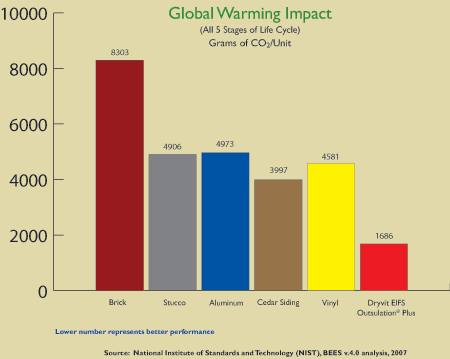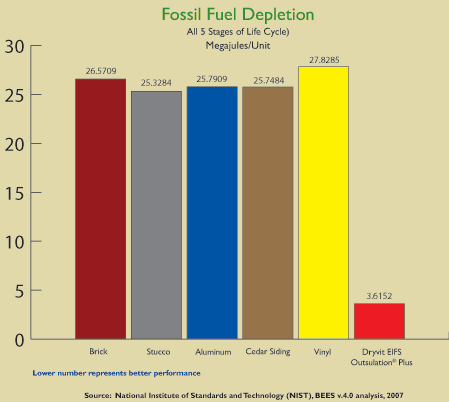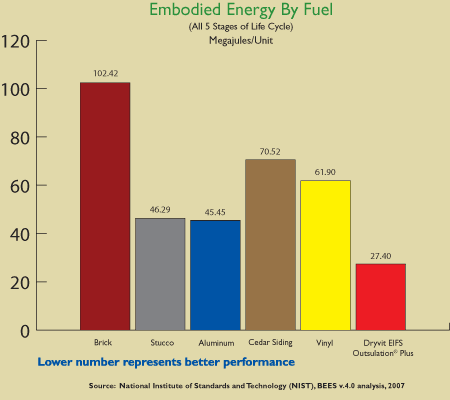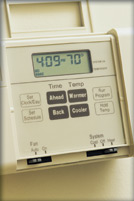It’s all about having the smallest environmental footprint possible
At Dryvit, we are fully committed to providing cladding options that help you meet your green design objectives. This commitment has manifested itself in several ways: from earning the ISO 14001 certification, to making sure our carbon footprint is as small as possible throughout the life cycle of our products including extraction, manufacturing, transportation, construction and building use.
In a comprehensive Life Cycle Assessment (LCA) completed by the National Institute of Standards and Technology (NIST), Dryvit Outsulation systems were shown to have significantly less adverse impact on our environment than brick, stucco and other claddings.
The charts below illustrate parts of the NIST study of the life cycle
advantages of Dryvit Outsulation systems.



There are several ways that using Dryvit systems or finshes can help you earn LEED credits.
New Construction
Energy and Atmosphere (EA)
 EA Prerequisite 2 requires exceeding the minimum energy efficiency requirements of ASHRAE Standard 90.1-2004 by 14% by calculation methods such as the Energy Cost Budget model. ASHRAE 90.1 describes a decrease in operating cost by reducing the total energy consumption as well as ‘time of day’ or ‘time of season’ demand changes. EA Credit 1 calls for percent improvements over ASHRAE 90.1 criteria through one of three prescriptive methods of calculating energy performance, all of which allows for an energy cost comparison between the proposed design and a baseline building. The energy savings provided by Dryvit Outsulation systems help to exceed these minimum requirements. EA Prerequisite 2 requires exceeding the minimum energy efficiency requirements of ASHRAE Standard 90.1-2004 by 14% by calculation methods such as the Energy Cost Budget model. ASHRAE 90.1 describes a decrease in operating cost by reducing the total energy consumption as well as ‘time of day’ or ‘time of season’ demand changes. EA Credit 1 calls for percent improvements over ASHRAE 90.1 criteria through one of three prescriptive methods of calculating energy performance, all of which allows for an energy cost comparison between the proposed design and a baseline building. The energy savings provided by Dryvit Outsulation systems help to exceed these minimum requirements.
Credit 5 requires 10 percent of all building materials to be extracted, harvested, recovered, as well as manufactured within 500 miles of the project. Dryvit’s five production facilities in North America allow a largepercentage of projects to be eligible for this credit.
Innovation & Design Process
 Using Dryvit Outsulation systems affords the opportunity to be awarded points for exceptional performance above the requirements set by the LEED-NC Green Building Rating System and/or innovative performance in Green Building categories not specifically addressed by the LEED-NC Green Building Rating System. The extraordinary energy efficiency of Dryvit Outsulation systems, as defined by the Oak Ridge National Laboratory’s study that found Dryvit Outsulation systems to be 84% more energy efficient than six other common cladding choices, helps meet the credit requirements. Using Dryvit Outsulation systems affords the opportunity to be awarded points for exceptional performance above the requirements set by the LEED-NC Green Building Rating System and/or innovative performance in Green Building categories not specifically addressed by the LEED-NC Green Building Rating System. The extraordinary energy efficiency of Dryvit Outsulation systems, as defined by the Oak Ridge National Laboratory’s study that found Dryvit Outsulation systems to be 84% more energy efficient than six other common cladding choices, helps meet the credit requirements.
Renovation
Materials and Resources - Building Reuse
The building envelope has a significant impact on energy performance and operating costs. By retrofitting the building’s exterior with Dryvit Outsulation systems, you have the potential to solve a multitude of existing building ailments such as poor insulation and excessive air infiltration. See examples below comparing Dryvit’s Outsulation system to brick.
Help is a phone call away
Dryvit has a LEED-accredited professional on staff who is available to
field your questions about using Dryvit Outsulation systems to help earn LEED credits.
For assistance, call Dryvit’s Engineering Department at 1-800-556-7752, ext.420 or visit our web site at www.dryvit.com/green.asp.
Tiny footprint - huge benefit
|
